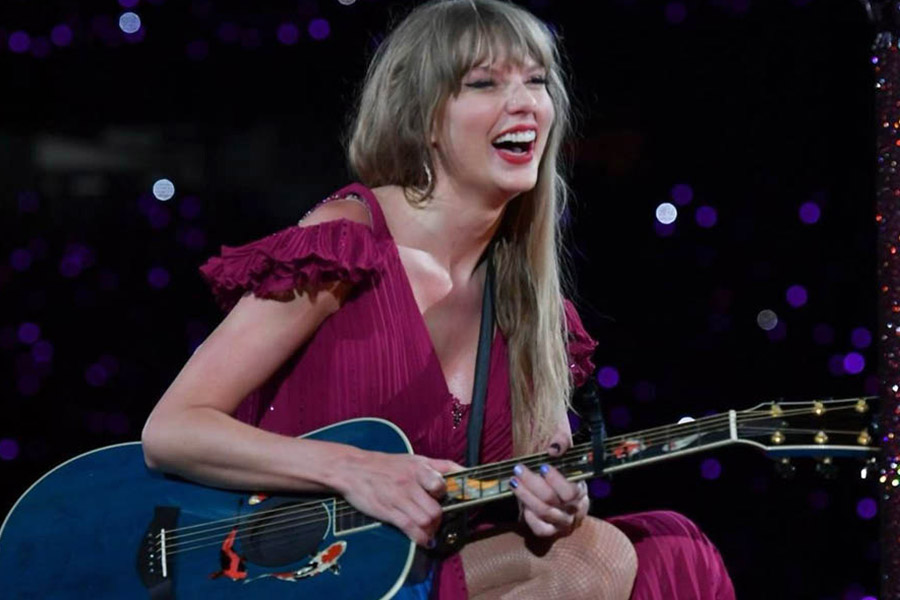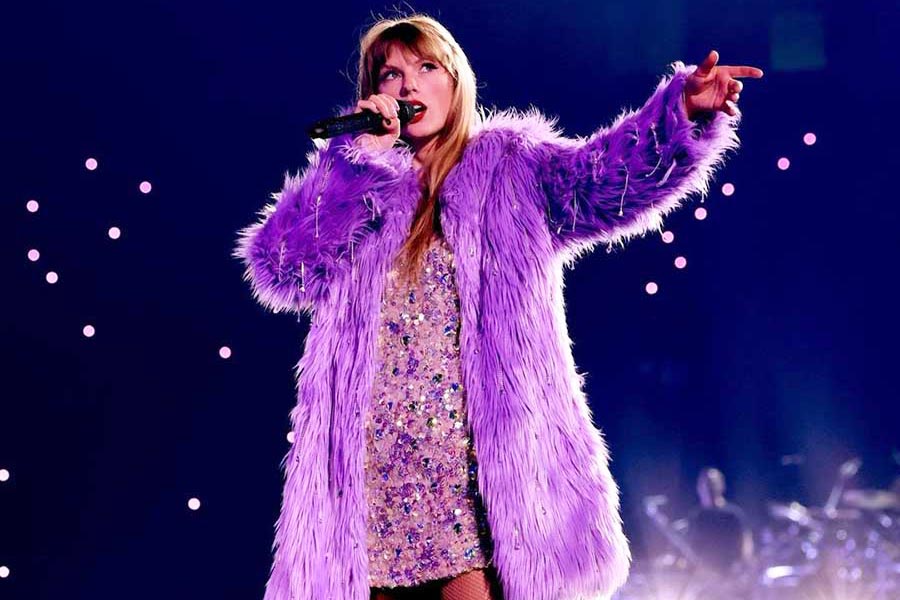Taylor Swift is ‘Barbie-coded’ for a lot of reasons. She is tall and slender with blonde hair and blue eyes. You are unlikely to see her in anything that does not ooze vintage or classic flair. Even at 34, Swift is still coming of age, marked by her innocence, wholesomeness and girl-next-door charm, chaperoned by her girlfriends everywhere she goes, unwilling to settle for just another Ken. Like Barbie, Swift has undergone various transformations throughout her career, from country singer to pop superstar. Just like Barbie, every appearance of Swift becomes a cultural spectacle. In the presence of Barbie or Swift, there is no room for anything else. No wonder then that award snubs for these female icons — be it at the Oscars or the Grammys — begin to matter more than thousands of deaths categorised as “collateral damage”.
Last December, I defended Swift while texting a good friend about girlhood subculture and the flak it often receives for encouraging a problematic escape from the complexities of womanhood, allowing women to participate in mass cultural femininity without engaging in meaningful political discourse. When my friend compared Swift to Margot Robbie’s character in Barbie, I said, “No, she’s like that kid who calls Barbie a fascist,” to which he replied, “But c’mon, Swift is a perpetual adolescent. She’s been a teenager since I was a teenager!” He rarely uses exclamation points, so I knew I had to take him seriously, but not until Swift herself showed me why he was right.
A poet whose art is centred on the self
When Swift announced the reissue of her latest album, The Tortured Poets Department (TTPD), hours after its initial release, she wrote on Instagram: “And the story isn’t mine anymore...it’s all yours.” Within hours of her releasing the music video of the first song in the album, there were hundreds of videos on YouTube dissecting the Easter eggs that Swift often leaves in her work for her fans to decode. These Easter eggs are hidden messages, references or clues that are often subtle and demand careful observation to decrypt. Incidentally, they also make for a guaranteed source of trending content that is both entertaining and interactive (even addictive), making it well-suited for short-form video platforms like Instagram reels and TikTok. Swift benefits from the attention economy, where attention is a scarce and valuable resource. Her story is not hers anymore, and yet the “dead author” (looking at you, Roland Barthes) benefits more than anyone else.
When we think about great art, we think about work that forces us to slow down and takes us away from the attention economy. It is the kind of art that breaks the automation of the everyday droll. Poetry is one such form, and Swift insists she is a poet. Pop culture writer Ria Chopra analysed some of Swift’s Easter eggs, noting how Swift compares herself to Romantic poets from the 18th century in one of her songs, references Robert Frost in two, and talks about how a classic like Daphne du Maurier's Rebecca inspired the narrative in another. As Chopra points out, Swift hits the nail on the head when she plays the character of a girl caught in a volatile love affair turning into a novelist at a book signing in the music video of “All Too Well”. Swift further reinforces the idea of her as an author or poet in her social media posts by ending her TTPD album with a song titled “The Manuscript”, meant to serve as a retrospective take on “All Too Well”. An American genealogy company has even revealed that Swift is related to Emily Dickinson.
The crown of literary authorship sits so heavy on Swift’s hyper-commercialised head that you cannot tell the difference between Swift, the artist, and Swift, the product. Although Swift's ‘art’ takes the listener away from the humdrum, the intention is to unpack how her songs fit into the larger storyline of her life, as opposed to the emotional resonance of her craft. That is secondary. As her songs prop her up on a pedestal, Swift becomes the cynosure of the perceived intertextuality — where everything ultimately returns to her. Her relationship with her listeners begins to resemble that between a marketer and a consumer, under the veneer of a parasocial bond. The give and take between an artist and her audience is reduced to taking for the most part.
And Swift takes a lot. In 2020-21, after releasing her critically acclaimed albums, Folklore and Evermore, Swift began putting out re-recorded versions of her earlier albums, bestowing them with the “Taylor’s Version” tag to regain control over her master recordings. Then, in 2023, with a record-breaking tour and a blockbuster movie, Swift became a billionaire, sashaying towards the top echelons of Forbes’ “Richest Self-Made Women” list.
Swift and her fans make it seem like she does it all on her own
Feminism does not quite work the same way for Taylor Swift and a black or Asian female artiste. Weird Barbie could not control the kid playing with her, and she was defaced and worn out, isolated by the other Barbie dolls in Barbieland, the ones lucky enough to be played with the right way. She never gets the redemption she truly deserves because all the focus shifts to Stereotypical Barbie’s temporary existential crisis. In our world, Swift is Stereotypical Barbie. As Time’s hagiographic profile on her rhetorically asks: “How many conversations did you have about Taylor Swift this year?”
But unlike Stereotypical Barbie, Swift is not interested in growing up. That would not fit into her campaign, which depends on, as she sings, the makeshift aphorism that “growing up precocious sometimes means not growing up at all”. And yet, Swift wants all the credit for “growing up” by reeling in the bait of burnt-out millennial productivity — “I cry a lot but I am so productive, it’s an art” — and fishing out a defensive “Try to come for my job” in an ironically upbeat song titled “I Can Do It With a Broken Heart”.
By making a song about universal experiences like burnout and heartbreak focus on herself, Swift seems to say she is the only one who can do what she does. Swift and her fans make it seem like she does it all on her own, casting an invisible spell on the sheer workforce it takes to plant all the Easter eggs in all the material associated with her and sell the products in a way that extends her album’s muddled storyline. This storyline implicitly reflects a shrewd businesswoman who knows she sells better than anyone else in the industry, claiming that she is limitless. (You can as well if you buy a TTPD-themed cardigan marketed for “those who get a bit chilly during [their] board meetings”) .

Swift’s precociousness also grants her the moral permissibility to ignore the rest of the world TT Archives
TTPD leaves many questions unanswered, but that is the point. Swift has outsourced that task to her listeners, who happily do it for free, like unpaid interns grateful to be associated with Swift’s mythmaking. Swift’s precociousness also grants her the moral permissibility to ignore the rest of the world, including the seat, rather the throne, she occupies in it. When you are a perpetual adolescent, “everything comes out of teenage petulance”, as Swift sings. But being a teenager does not stop you from being a businesswoman. It just means that the spurious things you do are blanketed or justified under the guise of a conflict that is part of the Bildungsroman genre: Swift is heartbroken and tired, just like her listeners. Her perceived bad behaviour is alright. Would all of us not react the same way?
At the end of the day, Swift, tortured poet or otherwise, is just another white American girl. Her artistry operates on a single frequency, broadcasting messages that resonate only with those already tuned into the station. I am too far from the transmitter to listen, the antenna of my radio has always been faulty, and the weather has gotten worse. I do not have time to tune in for Swift.
Diya Isha is an editor at a Delhi-based publishing consultancy. You can find her on Instagram @contendish


